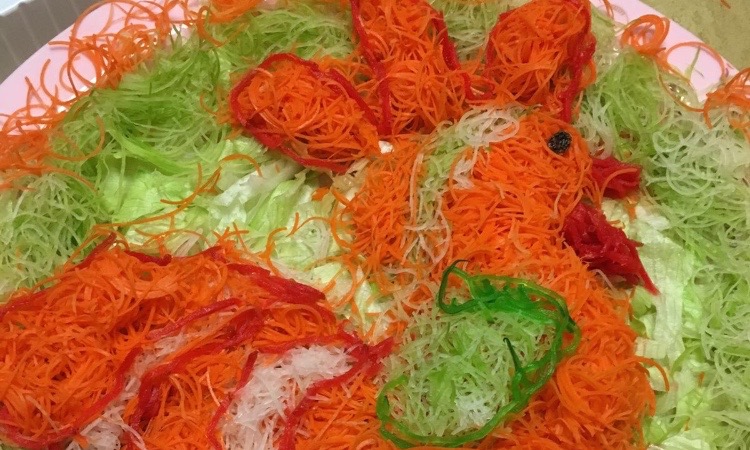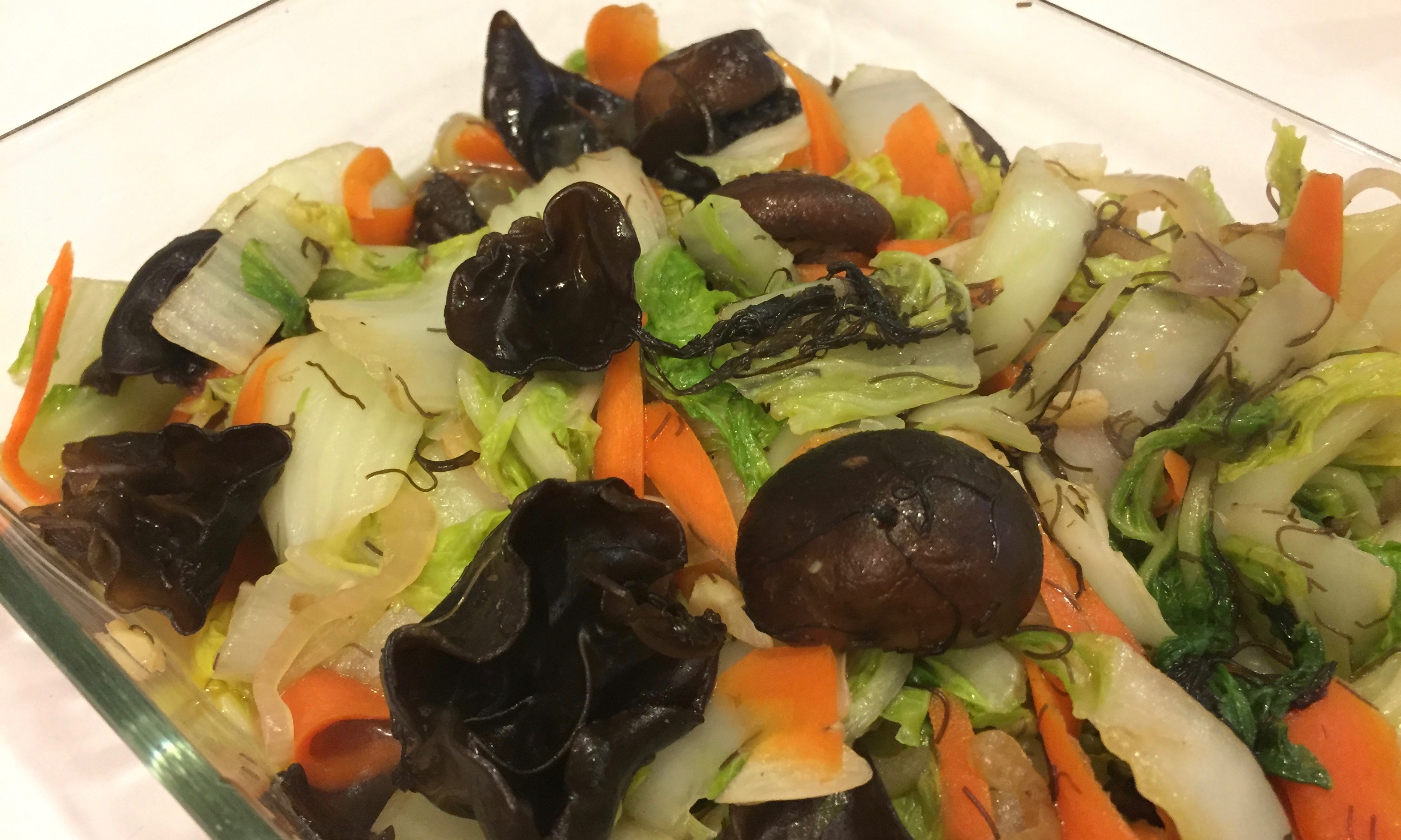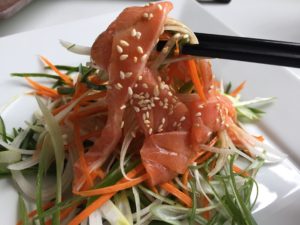
Here’s another festive food tradition enjoyed during Chinese New Year–raw fish served over an abundance of fresh vegetables. And the best part of this one is how it’s tossed with much vigor and gusto!
The tradition is called Lo Hei which translates into mixing (lo) and bringing up (hei, alluding to advancement and prosperity.) The dish itself is called Yu Sheng, simply meaning raw fish but the characters also sounds like abundance and growth.
Diners stand around the table and dig in–or up–tossing the ingredients together with purpose and in great fun. As they toss and toss, higher and higher, they are also calling out their wishes for the new year.

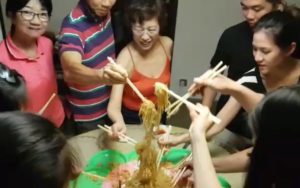
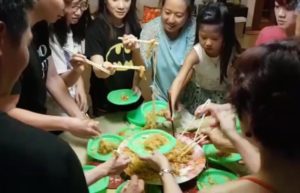
My friend Ruby Chuah sent me these pictures of the event with her family–children, in-laws and grandchildren–everyone tossing and mixing and having a grand time and then eating it all! What a happy event!
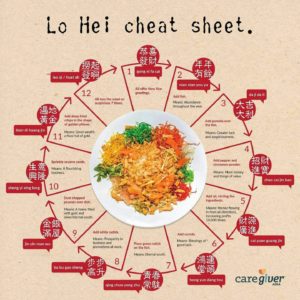 Ruby said this year a Lo Hei cheat sheet has been passed around and everyone has enjoyed learning the significance on the ingredients in the dish. Fish representing abundance, dribbled oil representing the flow of money, sesame seed for good business and more. The details are interesting. You can imagine business folks taking these to heart as they look optimistically to the new year.
Ruby said this year a Lo Hei cheat sheet has been passed around and everyone has enjoyed learning the significance on the ingredients in the dish. Fish representing abundance, dribbled oil representing the flow of money, sesame seed for good business and more. The details are interesting. You can imagine business folks taking these to heart as they look optimistically to the new year.
All this is new to me now I am so far away in the U.S. Decades ago Mum used to take us to Chinatown to eat Yu Sheng as our yearly tradition, and she and my Popo would say we are to mix the dish together. But we had no stand up theatrics. And I never saw people nearby on their feet throwing shredded veggies either. My sister says sometimes they are strewn out of the plate, table and beyond! New traditions just get tossed in over the years, I guess, making it fun and adding new meaning.
Basically, Yu Sheng is mixed salad with finely sliced sashimi. The dressing is simple, a subtle blend of calamansi juice, soy sauce, plum sauce to give it sweetness and fragrant sesame oil.
I’ve not seen this tradition observed in Taiwan or Hongkong, it must be Singaporean and Malaysian. During these 15 days of the lunar new year, restaurants that serve only this special dish are packed with happy diners. I wish they offered this year round; the raw fish and fresh radish, carrot, cucumber are such healthful ingredients. You can palpably feel the fresh daikon and carrot in the air when you enter the restaurant.
Here is how Ruby and her niece presented her Yu Sheng in the theme of the Year of the Rooster. The fish and trimmings and condiments are added during the Lo Hei mixing.
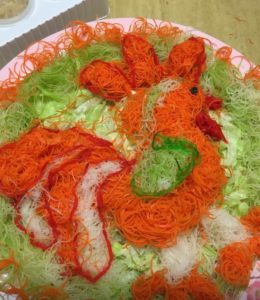
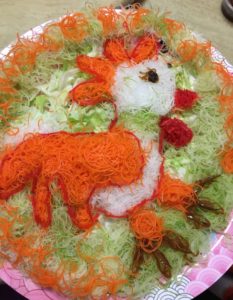
Inspired by these I decided on a whim to make some Yu Sheng myself. Minus the Picasso attempt it should be easy, especially since I didn’t have 10 people to feed. Festive food aside I think Yu Sheng makes an interesting starter dish.
In Singapore supermarkets sell Lo Hei kits. I’m simplifying mine and doing it from scratch. Our Korean restaurants have super fresh sashimi that I can buy. I have a choice of salmon or tuna. In Singapore we also use tenggiri, which is Spanish mackerel.
Instead of having to clean a food processor, I’m using my handy dandy julienne peeler. A great time saver, I’ve blogged about this nifty tool. Click here to read about it.
I selected one of those humongous fat carrots that you can find only in Asian stores. This bigger root can give me a good shred of carrot which the regular scrawny carrots can’t. Scrawny carrots are perfect treats for horses.
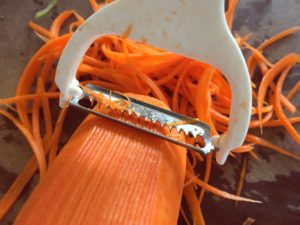
I used Persian cucumber because they are sweeter and not too seedy. Scrape around the green and leave the seed.
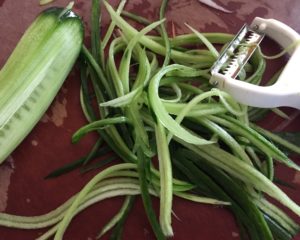
A friendly shop assistant in H-Mart told me Korean radish was sweeter than regular radish which is slightly bitter with a slight bite to it. The Korean version is more rounded and has some light green on it.
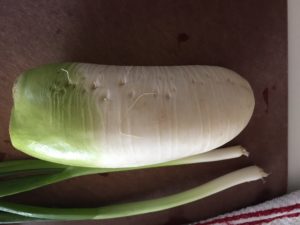
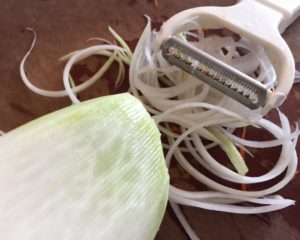
The amount of vegetables I used was 1 cup each, loosely packed. I’m presenting this as a light, starter dish.
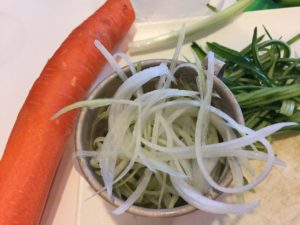
I got a filet of sashimi-grade salmon and sliced it thinly which is the way Yu Shang is supposed to be.
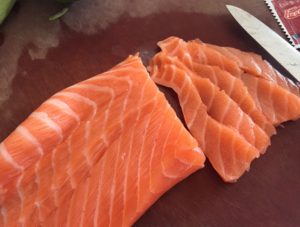
My Filipino cook Dory Sanda taught me long ago to squeeze calamansi juice over fish to cure it. The Filipinos also have a raw fish dish with Spanish Mackerel, which they call tanigi. So I did that before adding the rest of my dressing.
Here’s my modest, simplified version.
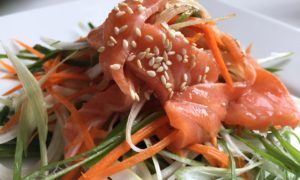
Simplified Yu Sheng
As a starter dish, serves four
Preparation time: 20 minutes
1 cup loosely-packed, julienned radish
1 cup loosely-packed, julienned cucumber
1 cup loosely-packed, julienned carrot
3 stalks spring onion, finely sliced
¼ pound sashimi-grade salmon or tuna
1 wedge slice of lime
1 teaspoon roasted sesame seeds
Soy sauce-sesame oil dressing
1 tablespoons soy sauce
½ tablespoon plum sauce
¾ teaspoon sugar
1 tablespoons lime juice
1 tablespoon water
1½ tablespoons sesame oil
Prepare the vegetables and place vegetables decoratively over a serving platter. Cover loosely in plastic wrap until ready to eat. Leave fish filet in refrigerator until ready to serve.
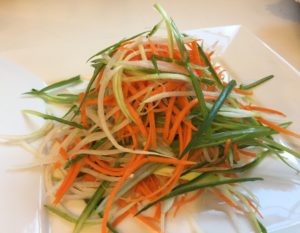
To make dressing, combine soy sauce with plum sauce, sugar, lime juice and water. Blend well. Add sesame oil and mix well. Set aside.
When ready to serve, finely slice salmon and place neatly over the bed of shredded vegetables.
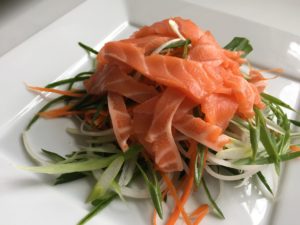
Serve fish with dressing at the table. Squeeze lime juice over fish and then dribble dressing over fish and vegetable. Add sesame seeds. Toss with enthusiasm and enjoy!
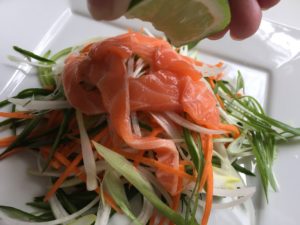

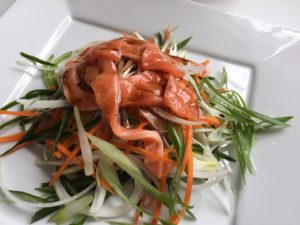
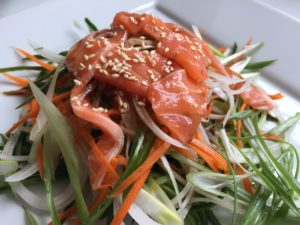
NOTES
A friend just told me cucumbers are not included. ( I didn’t know.)
These ingredients are also included in traditional Lo Hei:
–chopped peanuts
–pickled ginger
–pomelo
–wonton strips
–jellyfish
–cilantro
–pickled leeks
